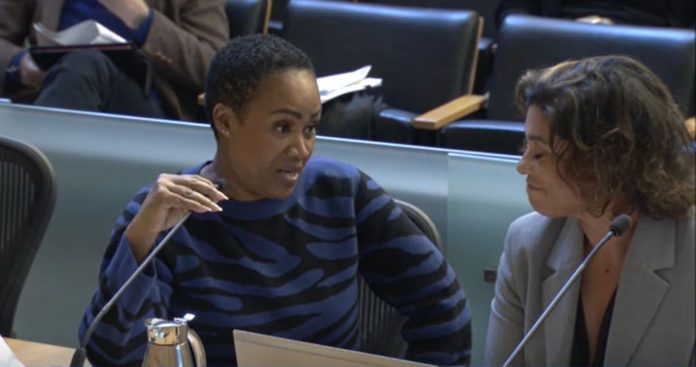
The auditor called for more coordination around gun violence prevention and SPD’s haphazard approach to investigations.
In late March, the City Auditor’s Office released a report on gun violence patterns in Seattle. The report found that Seattle could be doing a better job collecting and presenting data about gun violence and coordinating a response. The auditor emphasized the importance of using evidence-based problem-solving models to address gun violence and recommended expanding the Community Assisted Response & Engagement (CARE) department to coordinate violence prevention programs.
Shootings with non-fatal injuries increased by 150% and fatal shootings increased by 220% between 2013 and 2024, according to the Seattle Police Department (SPD). That troubling trend includes an increase in youth gun violence, with the number of youth gunshot victims doubling from 2019 to 2024, as the King County Prosecutor’s Office noted in its annual report.
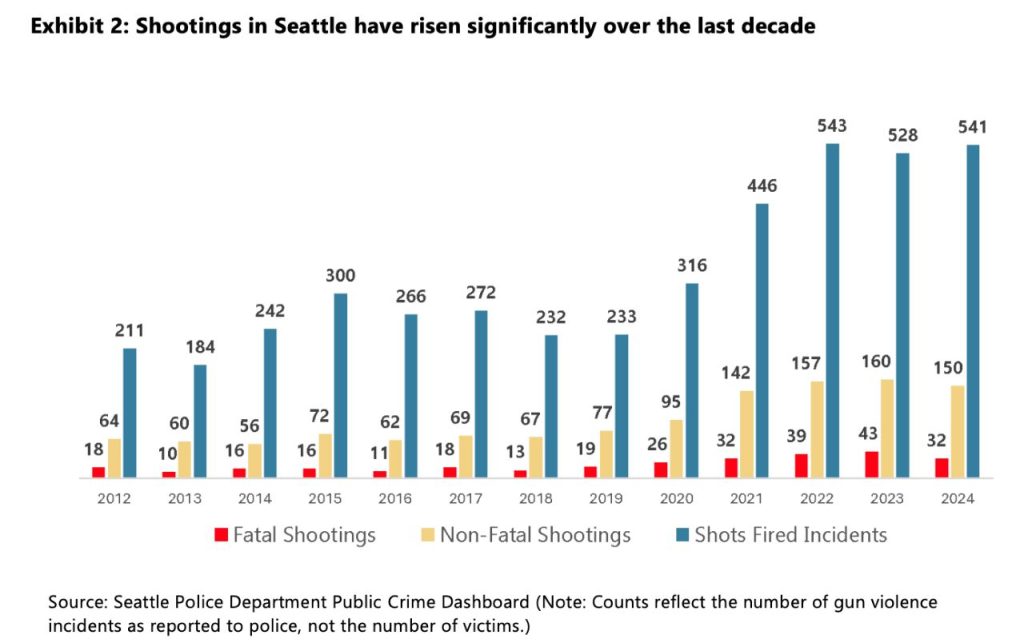
Regional gun violence decreased from 2023 to 2024, according to that same report. That downward trend was reflected in a slight decrease in non-fatal and fatal shootings recorded in Seattle in 2024. However, gun violence is still more prevalent than it was before the Covid pandemic.
The final auditor report made four main recommendations to the City regarding their gun violence prevention efforts:
- That the City should “develop systematic reporting on gun violence patterns” to all involved bodies as well as the public;
- That the City should provide an update on CARE’s original mandate to integrate violence prevention programs;
- That the City should “improve its capacity for problem analysis to address gun violence” while using an “all-hands-on-deck” approach; and
- That the City should implement a framework for “regular systematic coordination” between City departments, other government entities, and community organizations.
The report also offered an item for city council consideration: to improve the Seattle Police Department’s (SPD) investigations process. In the auditor’s assessment, SPD investigation practices varied widely across precincts and were poorly standardized and lacking in a system to track performance metrics and ensure effective communication between detective squads and other parts of SPD.
The Mayor’s Office struck a defensive tone in the presentation of the auditor’s report to city council in late March, including what appeared to be resentment that the audit had happened at all.
“I would say the Mayor’s Office agrees with the audit findings, but we were already doing the things that were in the audit findings, and there’s a big distinction,” Deputy Mayor Tiffany Washington said.
Washington delivered a list of accomplishments of the Mayor’s Office that included items like the Seattle Restoration Framework, establishing the CARE department and Unified Care Team, and that the liaison for gun violence in the Mayor’s Office has enrolled in a workshop.
“I just want to take a moment to recognize and give ourselves some kudos for the work we’ve already done,” Washington said.
A lack of coordination
Three of the four audit recommendations relate to the need to have more coordination, both around sharing gun violence data and in prevention efforts, most likely through a central person or governmental body.
“The report also shows that the City needs to prioritize further data sharing with our community,” Callie Craighead, a spokesperson for the Mayor’s Office, told The Urbanist. “SPD will further its existing plan to expand and improve its online reporting to match this year.”
However, the cities used as examples in the auditor’s report do not rely on solely police reporting for their gun violence data. City Auditor Research and Evaluation Director
Claudia Gross Shader, who was the lead author of the report, told The Urbanist that In addition to police data, other cities incorporate data from local prosecutors and community organizations. The City also doesn’t currently have access to data about gun violence from King County’s Regional Office of Gun Violence Prevention, housed within Public Health – Seattle & King County.
“I suppose a police department could pull in data from multiple sources, but that seems like a lot of convening and coordination to ask of any police department,” Shader said. “So that’s why convening agencies in multi-agency coordination frameworks usually exist outside of the police department.”
Among the other reasons to have another entity do the data collecting and sharing include logistical considerations and using a more neutral body to share data and convene discussions in order to build trust with community organizations, Shader said. Such a department may already have the capacity and staff to do the work, unlike SPD.
The report suggests looking into the ability of the CARE department to be the coordinator of the City’s gun violence prevention efforts. The Seattle City Charter includes the role of integrating Seattle’s violence intervention programs among CARE’s functions..
Shader told The Urbanist Public Health could also make sense as a convener because of the regional nature of gun violence.
In March, CARE Chief Amy Barden presented an update at Council’s public safety committee meeting, during which Councilmember Martiza Rivera asked why CARE wasn’t working on this part of its original mandate.
“I have stressed the urgency that we have got to get more expeditious in the way that we organize the work,” Barden told the council. “I have not been endorsed to do that part of the work yet.”

She said Deputy Mayor Tim Burgess had told her she didn’t yet have the capacity to perform that function of the CARE department.
Barden told The Urbanist that she thinks de-siloing public safety efforts would lead to better outcomes.
“I felt like the task was to coordinate efforts around public safety, meaning prevention, deflection, diversion, coercion, re-entry. So basically, when we have somebody who’s in a space of either crime or crisis, is there an entity that can have a line of sight into the journey of that person, what’s working, what’s not working,” Barden said. “And I love that design. That hasn’t been done well anywhere in the country, and I love the possibility that Seattle could be the first.”
Barden said the next step towards allowing CARE to perform a more robust coordination role would be investment during the mid-year supplemental budget process this summer. CARE is currently a small department without much administrative support so would require a larger budget to take on more work.
“It doesn’t have to be like this,” Barden said. “I’m all over the country. There are models and interventions that work. We do have enough money, we certainly have enough intellect and kindness in this city to have better results than we have. But philosophically, I really do believe in community and that our little villages across our neighborhoods need to be either rebuilt, or some are really doing well and they just need to be strengthened.”
Barden emphasized the need for the City to coordinate and cooperate with King County, and she believes the leadership of Seattle’s Chief Public Safety Officer Natalie Walton-Anderson will help get the City where it needs to be.
The auditor’s report similarly identified a need for better coordination between various agencies and groups.
The King County Prosecuting Attorney’s Office’s (KCPAO’s) Crime Strategies Unit shared that in Seattle, shootings concentrate in and around parks and community centers. The Seattle Parks Department didn’t have a complete list of shootings that have happened in the parks, but SPD was able to create a custom report, generating a list of 11 parks that see a high incidence of shootings and could use extra attention.
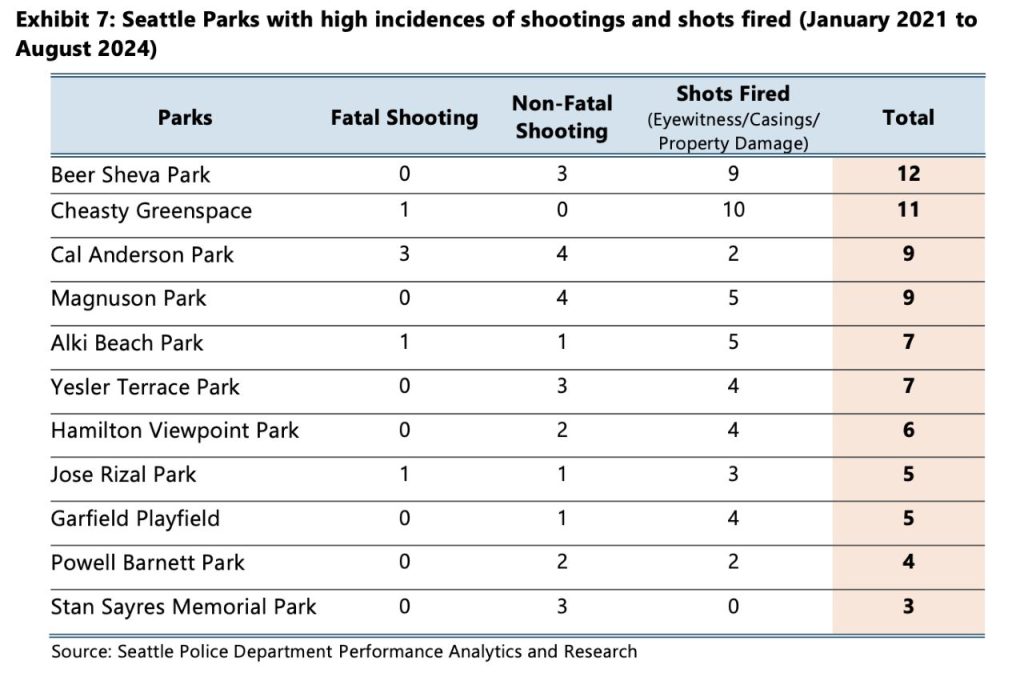
Likewise, data suggests a nexus between homeless encampments and gun violence. An analysis prepared by the Police Executive Research Forum and KCPAO found that 89.33% of gun violence incidents at homeless encampments in King County between 2021 and September of 2024 occurred within Seattle. Strategies to reduce this nexus of gun violence might differ from more general prevention strategies.
Evidence-based problem analysis
Another key recommendation in the report is for Seattle to improve its ability to conduct problem analysis using evidence-based techniques.
“This is what we’ve recommended in, now, multiple audits,” Shader said. “These are important issues. These are life and death issues, whether it is overdoses or crime and victimization or violent crime, and gun crime, and so we need to make sure that we are addressing these issues using a thoughtful, proven framework.”
The report cites examples of cities using homicide review commissions, violence reduction councils, place network investigations, problem–oriented-policing, and the Strategic Prevention Framework (SAMHSA) or similar frameworks.
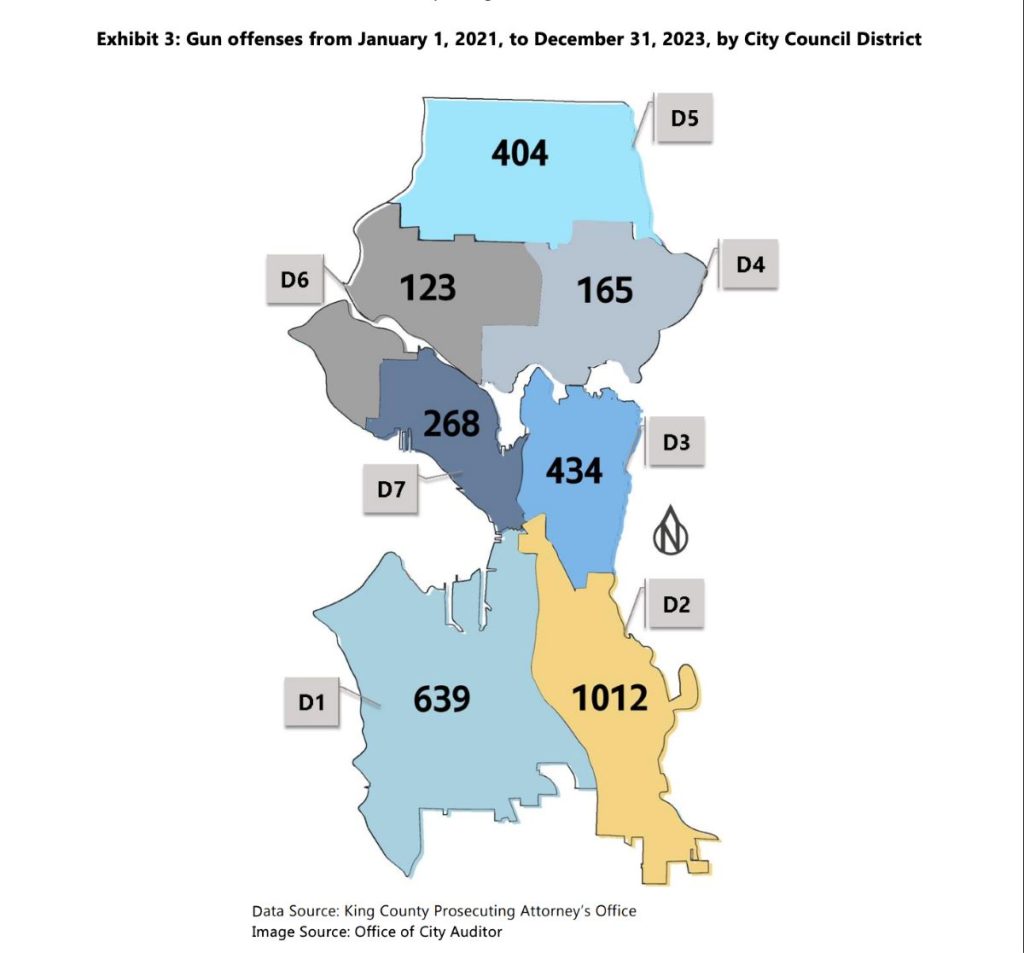
“[SAMHSA] leads you through a step by step [process], and you document things so that nothing slips through the cracks, and so that you are evaluating and making changes as necessary,” Shader said. “And ultimately, you can have an understanding of whether or not your efforts are hitting the desired results, and so that’s what we’re recommending.”
SAMHSA inspired a framework that was used for Rainier Beach: a Beautiful Safe Place for Youth from 2013-2016.
The SAMHSA framework is currently being used by the Phố Đẹp (Beautiful Neighborhood) Little Saigon Safety Plan, originally reported on in PubliCola. This new plan calls for interventions like increased cleanliness and character in the neighborhood, organizing a neighborhood watch, increasing social service outreach, and organizing more community events.
The initiative has received $65,000 in City funds for capacity building, but would be able to do more if better resourced.
SPD’s investigations
The report also includes an item for city council consideration, citing a 2023 report from the Center for Evidence-Based Crime Policy (CEBCP) about the state of SPD’s investigative operations. The CEBCP report found significant weaknesses in SPD’s investigative practices, including:
- No manuals, policies, or procedures for investigations;
- Informal and uneven selection, onboarding, and training practices for new detectives;
- Wide variation in common investigatory practices across units;
- Inability to track cases and the performance of specific units in a standard way;
- Poor communication between patrol and investigation bureaus, and
- Weak strategic command and supervision.
Damningly, the CEBCP report had this to say about SPD’s functional weaknesses: “The GMU team found that the SPD has been focused on the physical organization and reorganization of its investigative units rather than on more substantive, strategic, and operational concerns of the bureau and its units. Because of this, the agency has been impacted by the loss of detectives and has been unable to weather current crises. Even if the SPD returns to full sworn and nonsworn capacity in the future, these organizational weaknesses will remain if unattended.”
“Investigations can be an important source of data to help us understand more about gun violence patterns,” Shader said. “Investigations are a way to address gun violence too. So it seemed like there was an important nexus there.”
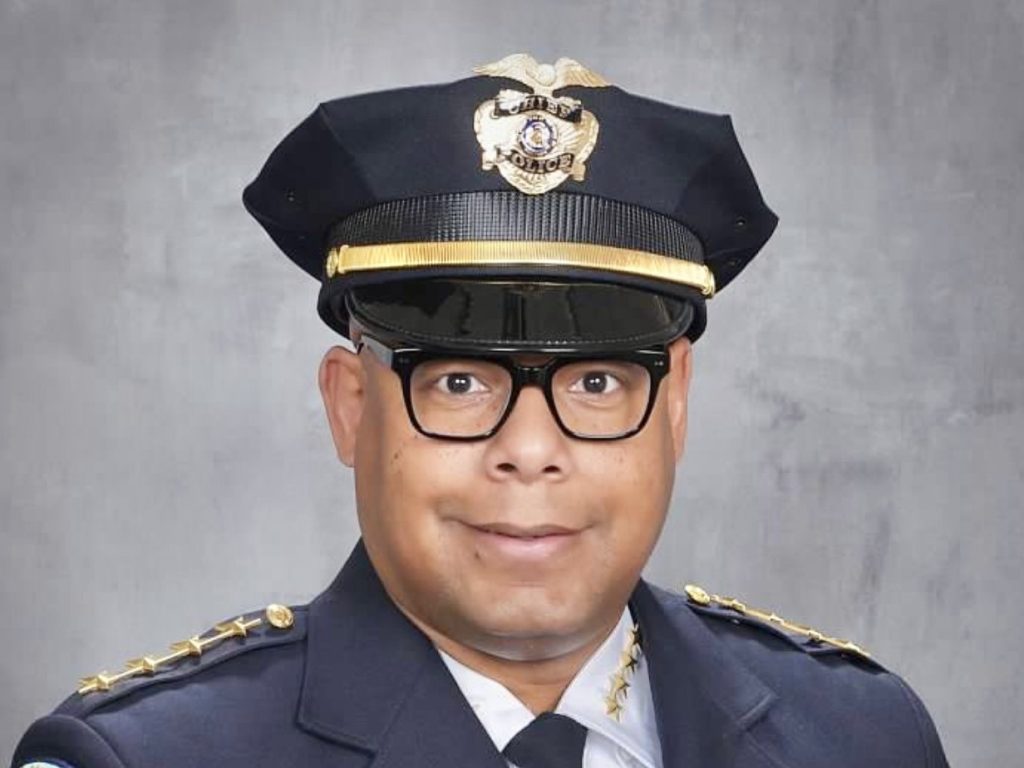
New SPD Chief Shon Barnes delivered a presentation to the city council on his plans for improvement in SPD’s investigations at the end of February. At that time, none of the items to improve investigations had been completed.
“We felt that was important to highlight for the council because one of our huge investment areas in gun violence is investigations,” Shader said.
The history of gun violence problem-solving in Seattle
Working with the Center for Evidence-Based Crime Policy, the City Auditor’s Office undertook a comprehensive crime prevention review in 2012. This report surveyed the City’s investments in crime prevention programs, both providing a catalog of programs and determining which of them had evidence of effectiveness. No similar report has been completed since that time.
In the fall of 2023 as part of the budget process, city council passed a statement of legislative intent, originally proposed by Councilmember Lisa Herbold. It requested that the Human Services Department and the Community Safety and Communications Center (since rebranded as the CARE department) conduct “a gap analysis of the City’s current and priority investments in gun violence prevention as compared to the recommendations in the King County Regional Community Safety and Wellbeing (RCSWB) Plan.”
The next year, Council President Sara Nelson introduced a resolution that eliminated several statements of legislative intent passed by the previous council, including the one about gun violence investments. Instead, she and Mayor Bruce Harrell requested an update of the original 2012 crime prevention report from the Office of the Auditor.
However, only a few months later, the Mayor’s Office requested that the audit be placed on hold. When Nelson learned about this last summer, she asked the Auditor’s Office to instead complete a more limited audit that would only cover the first of five originally planned topic areas around gun violence to increase the City’s understanding of the nature of gun violence in Seattle.
Although the final report on gun violence patterns was only released recently, the draft report was completed in November of 2024. While a more comprehensive report about crime prevention is still on the Office of the Auditor’s current work plan, it is currently on pause while the Human Services Department conducts their request for proposals (RFP) process for community safety programming this year.
Response from the Mayor’s Office
“The report validated the approach of our One Seattle Restoration Framework, which states that improving public safety within our city involves collaboration across multiple City departments and programs and taking a place-based approach to our needs, as seen with the launch of our Downtown Activation Team,” Craighead said.
The One Seattle Restoration Framework was released last October. The Auditor’s Office did not do a comparison of this framework with models from other jurisdictions, although Shader has offered to do so. Because the available documents on the One Seattle Restoration Framework are so high level, it is impossible to say how this framework compares to other evidence-based models.
Even so, the Mayor’s Office emphasized those efforts as showing momentum and follow through on the earlier audit.
“The audit that Claudia and her team did years ago still stands,” Washington said. “So my argument back was we don’t need to publish another report. Let us do the work from the last audit, which we tried to do.”
Washington said she didn’t feel respected or heard through this audit process. “I hold both the professional degree and the personal degree, and I deserve that respect,” Washington said.
Washington referenced that “bad things happened” involving organizations being under investigation and slowing down work in this area. She might have been referring to Marty Jackson, the Executive Director of the SE Network SafetyNet program run by the Boys & Girls Club, being indicted on federal charges related to drug trafficking last October. The SE Network had been contracted to provide violence intervention teams to Garfield High School and Rainier Beach High School, but upon news of the indictment, that program was paused.
The Seattle School District has current contracts with Community Passageways and Urban Family to “provide students mentorship, case management, and violence prevention support, including safe passage to and from school.” This program is active at Garfield High School and Washington Middle School, with implementation planned for Rainier Beach High School and Aki Kurose, Meany, and Mercer middle schools.
Craighead says the Mayor’s Office plans to incorporate the findings of the auditor’s report into existing strategies and initiatives. It is unclear whether the City will take advantage of any of the resources and technical advice Shader outlined in the report.
“In my remarks and the presentation, we said that we’re not calling for more police resources or more resources. We’re just calling for the city to be more coordinated,” Shader said. “And I guess I would say that right now, at this juncture with the financial situation, we can’t afford to not be coordinated.”
Amy Sundberg is the publisher of Notes from the Emerald City, a weekly newsletter on Seattle politics and policy with a particular focus on public safety, police accountability, and the criminal legal system. She also writes science fiction, fantasy, and horror novels. She is particularly fond of Seattle’s parks, where she can often be found walking her little dog.


